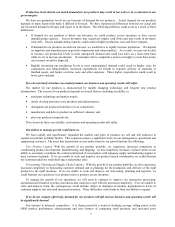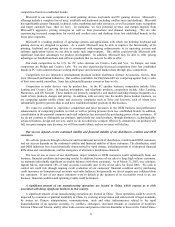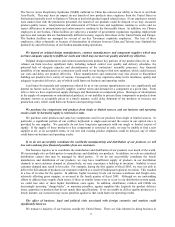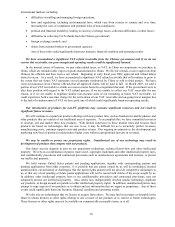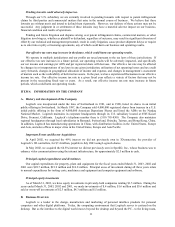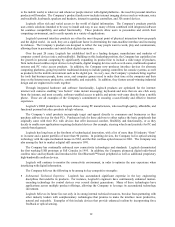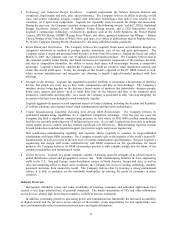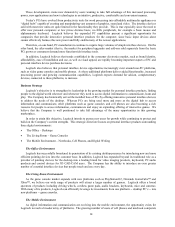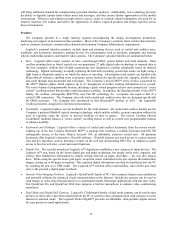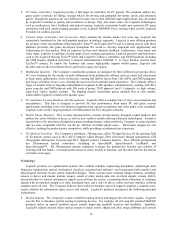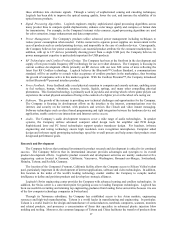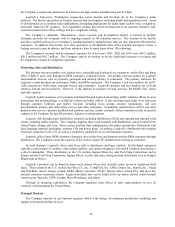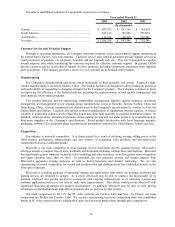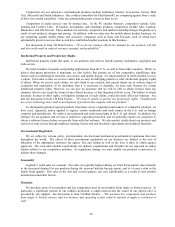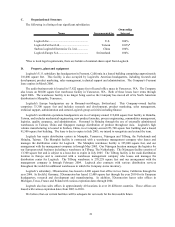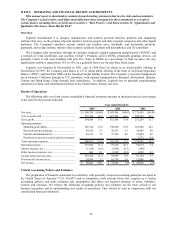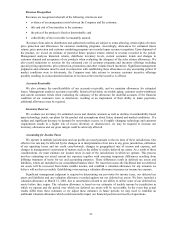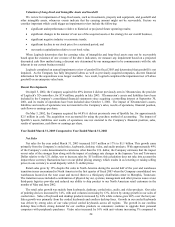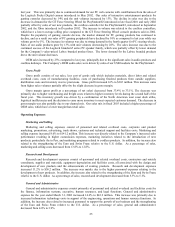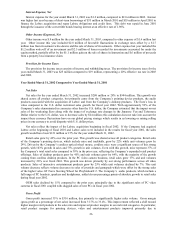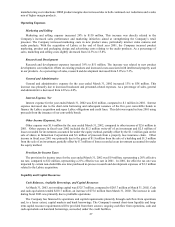Logitech 2003 Annual Report Download - page 122
Download and view the complete annual report
Please find page 122 of the 2003 Logitech annual report below. You can navigate through the pages in the report by either clicking on the pages listed below, or by using the keyword search tool below to find specific information within the annual report. 17
these attributes into electronic signals. Through a variety of sophisticated sensing and encoding techniques,
Logitech has been able to improve the optical sensing quality, lower the cost, and increase the reliability of its
optical mouse products.
• Signal Processing Algorithms. Logitech engineers employ sophisticated signal processing algorithms across
many product lines to compute spatial displacements, enhance color image quality and compress or format data
for transmission. For example, in the Company's internet video cameras, signal-processing algorithms are used
for color extraction, image enhancement and data compression.
• Power Management. The Company's products utilize advanced power management including techniques to
reduce power consumption when needed. Cables connected to separate power supplies are inconvenient in the
case of products such as corded pointing devices, and impossible in the case of cordless devices. Consequently,
the Company believes low power consumption is an essential product attribute for the consumer marketplace. In
addition, with up to 127 devices potentially drawing power from a single USB port, the Company believes its
power management expertise is particularly important for USB products.
• RF Technologies and Cordless Product Design. The Company has been at the forefront in the development and
supply of low power radio frequency (RF) technology for use over short distances. The Company is focusing its
current cordless development efforts primarily on RF devices with our new MX series of mice reflecting the
latest Fast RF Cordless technology. Logitech believes the Bluetooth™ Cordless Standard, a communications
standard, will be an enabler to a much wider acceptance of cordless products in the marketplace, thus boosting
the growth of companies active in this market segment. With the Cordless Presenter™, the Company introduced
its first Bluetooth™ personal interface product.
• Force Feedback. Force feedback adds a real physical sensation to computer and console systems, enabling users
to feel surfaces, bumps, vibrations, textures, inertia, liquids, springs, and many other compelling physical
phenomena. This licensed technology is primarily used in joysticks and steering wheels where game players can
experience the actual physical sensation of being at the controls of a fighter jet or at the wheel of a racing car.
• Software. The growth of the internet is providing new technical challenges and opportunities for the Company.
The Company is focusing its development efforts on the interface to the internet, communications over the
internet, and security on the internet, with products and services like iTouch and video instant messaging.
Software technologies such as object based programming and tight integration between the hardware device and
application, enable easier to use interactions and Internet service access.
• Audio. The Company’s audio development resources cover a wide range of audio technologies. In speaker
systems, the Company utilizes advanced computer aided design tools for amplifier and PCB design.
Sophisticated laser and PC based technologies support speaker transducer design. For headsets, in-house
engineering and testing technology ensure high resolution voice recognition microphones. Computer aided
design and in-house rapid prototyping technology speed the overall process and help assure that products meet
design and performance goals.
Research and Development
The Company believes that continued investment in product research and development is critical to its continued
success. The Company believes that its international structure provides advantages and synergies to its overall
product development efforts. Logitech's product research and development activities are mainly conducted at five
engineering centers located in Fremont, California; Vancouver, Washington; Romanel-sur-Morges, Switzerland;
Hsinchu, Taiwan; and Seefeld, Germany.
The location of the Company's Fremont, California facility allows the Company access to Silicon Valley's talent
pool, particularly important in the development of internet applications, software and video technologies. In addition,
this location in the midst of the world's leading technology market enables the Company to compile market
intelligence to define and position products and develop key strategic alliances.
Logitech's Swiss engineering center provides the Company with advanced sensing and cordless technologies. In
addition, the Swiss center is a convenient point for gaining access to leading European technologies. Logitech has
been successful in recruiting and retaining top engineering graduates from leading Swiss universities because it is one
of the few computer technology companies in Switzerland.
Through its Taiwanese subsidiary, the Company has established access to key Asian markets, engineering
resources and high-tech manufacturing. Taiwan is a world leader in manufacturing and engineering. In particular,
Taiwan is a world leader in the design and manufacture of semiconductors, notebook computers, scanners, monitors
and related products, and possesses a concentration of firms that specialize in advanced plastic injection blow
molding and tooling. Moreover, the common language of Taiwan and China facilitates the transfer of products from


